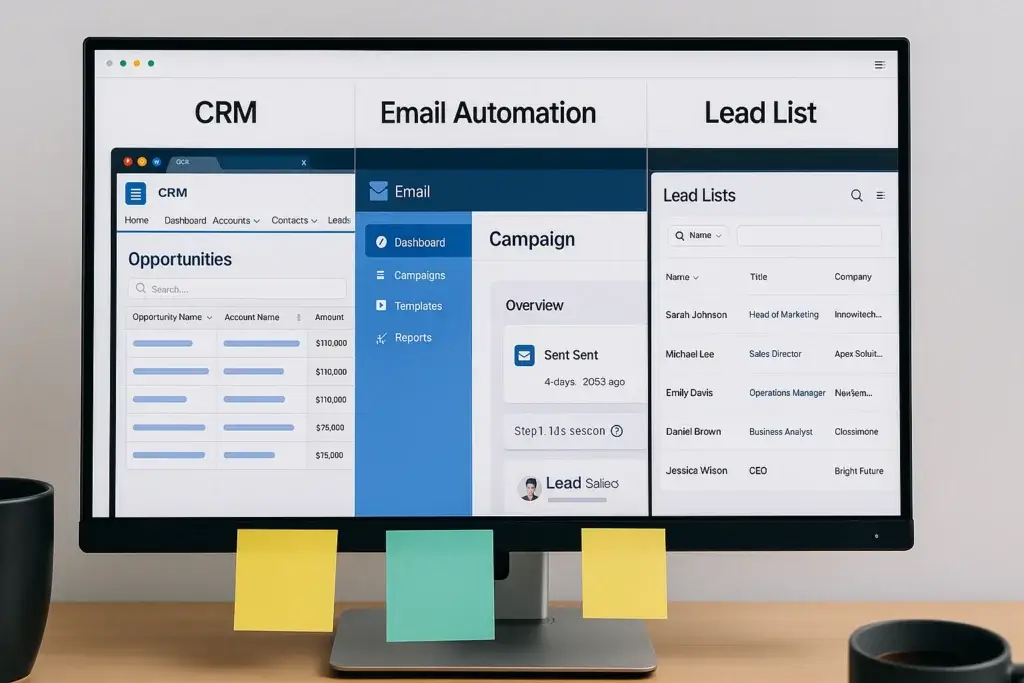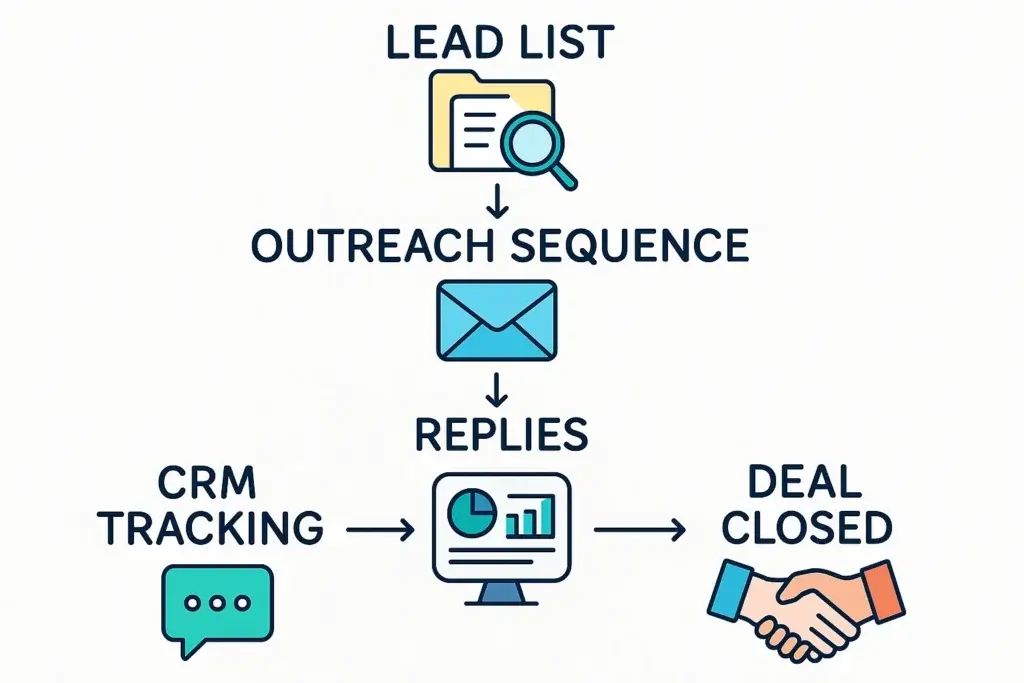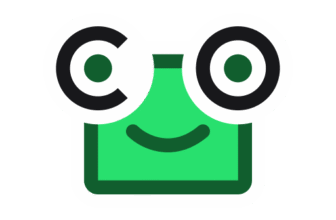
Why Outbound Sales Still Matter for Startups
When you’re building a startup, there’s one harsh truth: waiting for leads to come in isn’t always an option. If you’re aiming to grow fast, hit those early revenue milestones, or validate your product in-market, you need to go outbound. And no, outbound sales isn’t dead, it’s just evolved.
Outbound sales for startups is your proactive growth engine. It’s where you take control of your pipeline by reaching out directly to potential customers. Done well, it delivers faster feedback, quicker deals, and invaluable market validation.
In this guide, you’ll get a full playbook on how to launch and scale outbound sales, even with a lean team. We’ll cover the exact steps, tools, and ready-to-use templates you can deploy today. Whether you’re the founder doing it solo or hiring your first SDR, this guide is built for you.
What Is Outbound Sales?
Outbound sales is a method where you initiate contact with potential customers through cold emails, calls, or LinkedIn messages, instead of waiting for them to find you.
For startups, it’s often the most immediate way to:
-
Validate market demand
-
Reach high-value B2B buyers
-
Fill your pipeline when inbound efforts are still ramping up
If your product has a high ACV, targets a niche B2B segment, or solves a specific pain point, outbound is likely your best bet.
But outbound isn’t just about sending mass emails and hoping for replies. It’s about using sales intelligence tools to find the right contacts, crafting personalized messages, and tracking your engagement.
🔍 Three Sales Intelligence Tools to Kickstart Your Outbound:
-
SmartReach AI – Not just an outreach automation tool, but a full AI-powered platform that helps personalize emails, track replies, and optimize sequences for deliverability. It’s built with startups in mind and even shares powerful strategies like how to handle “I’m not interested” replies.
-
Apollo.io – Great for building lead lists, finding verified contact info, and integrating with your CRM to track the sales cycle.
-
RocketReach – Another contact database alternative, but if you’re comparing platforms, check out this detailed guide on RocketReach alternatives to pick the best fit.
When you pair the right tools with the right strategy, outbound becomes scalable and data-driven. Platforms like SmartReach AI even help you reach B2B open rates of over 50%, which is huge when you’re starting from scratch.

How to Build an Outbound Sales Strategy (Step-by-Step)
Launching your outbound engine doesn’t have to be overwhelming. Whether you’re the founder sending your first cold email or building a small SDR team, a clear structure can help you start strong and scale smarter. Here’s your step-by-step guide to building a repeatable outbound sales strategy for your startup.
1. Define Your ICP (Ideal Customer Profile)
Before you send a single email or make a call, you need to know exactly who you’re targeting. Your ICP is the blueprint of your perfect customer, not just industry or company size, but job titles, pain points, tech stack, and buying behaviors.
Pro tip: If you’re in B2B SaaS, start by looking at your early users. Who’s engaging the most? Who converted fastest? Reverse-engineer from there.
Bonus Tool: Use Apollo.io or Cognism to filter potential leads by firmographic and technographic data so you’re not shooting in the dark.
2. Build a Clean Prospect List
Now that you know your ICP, it’s time to create a targeted lead list. The quality of this list will make or break your outbound results.
You can:
-
Scrape and verify leads using tools like Apollo.io
-
Use LinkedIn with filters + Sales Navigator
-
Enrich contact info with tools like Hunter.io or Clearbit
Quick tip: Avoid buying bulk lead lists. They’re often outdated and full of low-intent prospects. A smaller, verified list will always outperform a bloated one.
3. Craft Personalized Outreach Messages
This is where most startups miss the mark.
No one wants to read a generic cold email that sounds like a robot wrote it. Your messages should be personalized, concise, and clearly communicate value.
Here’s a basic cold email framework:
-
Line 1: A relevant opener (e.g., recent LinkedIn post, company news, shared connection)
-
Line 2–3: Why you’re reaching out and how you can help
-
Line 4: Simple CTA (e.g., “Worth a quick chat next week?”)
Want better open rates? Use AI-powered writing assistants like Lavender to improve tone and structure in real-time.
4. Automate and Personalize with the Right Tools
Once you’ve built your prospect list and written your initial outreach messages, it’s time to scale. But that doesn’t mean blasting the same message to everyone, modern outbound only works when it feels personal.
The best way to scale without sounding spammy is to use tools that combine personalization with smart automation.
Platforms like HubSpot, Smartlead, or Reply.io help you set up outreach sequences that include:
-
Personalized cold emails
-
Follow-up reminders
-
LinkedIn touchpoints
-
Email tracking and performance metrics
Before sending, it’s essential to make sure your message speaks directly to each prospect’s context. That’s where tools like SmartReach AI can help, by using AI to enrich your leads with additional data and generate personalized lines based on job titles, industries, or even recent company news.
SmartReach doesn’t handle email delivery itself, but it integrates with platforms like HubSpot, Reply.io, and Smartlead, making it easier to create relevance at scale.
Bottom line: Outreach automation should never feel robotic. The best tools help you send fewer emails to better prospects, with messaging that actually resonates.
5. Track, Learn, and Optimize
Outbound is never a set-it-and-forget-it strategy.
Track metrics like:
-
Open rate (aim for 40%+)
-
Reply rate (8–12% is a strong benchmark)
-
Positive reply rate
-
Booking rate
CRMs like HubSpot or monday CRM integrate with SmartReach to help you automatically log email activity, track lead progression, and build reporting dashboards. This is where CRM becomes your command center, giving you visibility into what works and what needs improvement.
Tools You Need for Outbound Sales
You don’t need a bloated tech stack to build a winning outbound process. But choosing the right tools early on can save you time, boost response rates, and keep your sales pipeline organized. Here are four startup-friendly outbound sales tools you can rely on to streamline prospecting, outreach, and tracking.
1. SmartReach AI – Best for List Building and Lead Enrichment
SmartReach AI is a helpful addition to your outbound toolkit, especially during the lead research and personalization phase. Instead of manually pulling data from different sources, you can use its AI-powered engine to build targeted lead lists and enrich them with intent signals, job titles, company data, and more.
It connects with popular tools like HubSpot, Smartlead, and Reply.io, so once your lists are ready and personalized, you can push them directly into your outreach platform of choice.
Highlights:
-
AI-driven lead list building and filtering
-
Access to integrated data sources (e.g., Crunchbase, SimilarWeb, BuiltWith)
-
Personalized message lines for better relevance
-
Works alongside your existing email tools, it doesn’t send emails directly
It’s ideal for early-stage teams that want to automate the research-heavy parts of outbound without sacrificing accuracy or timing.
2. Apollo.io – Best for Prospecting and Contact Enrichment
Prospecting is half the battle in outbound. Apollo.io makes it easier by giving you access to over 250 million verified B2B contacts.
Key features include:
-
Advanced filters to build ICP-targeted lead lists
-
Verified email and phone data
-
LinkedIn integration for fast exporting
-
Real-time enrichment for your CRM
It’s ideal if you want to combine lead discovery and email outreach in one interface, especially for small teams trying to scale fast.
3. HubSpot CRM – Best Free CRM to Start Tracking Deals
As your outbound outreach starts converting into conversations, you’ll need a CRM to manage your pipeline. HubSpot CRM is a great place to start. It’s free, easy to use, and integrates with most sales tools.
Features that help startups:
-
Contact management and email logging
-
Deal tracking with drag-and-drop pipelines
-
Native integrations with SmartReach AI, Apollo, and more
-
Real-time reporting dashboards
HubSpot also gives you visibility into email opens and activity timelines, so you can follow up at the right moment.
4. Lavender – Best Tool to Write Better Cold Emails
Your messaging can make or break outbound performance. Lavender helps you write better emails by giving instant feedback on tone, clarity, and personalization.
Why startups love it:
-
Real-time AI writing assistant that plugs into Gmail or outreach tools
-
Score each email before you send it
-
Recommends improvements to improve replies
-
Helps you avoid spam triggers and cold email mistakes
It’s like Grammarly but built specifically for sales reps and founders writing cold emails.
Each of these tools solves a core challenge in outbound sales: finding the right people, messaging them effectively, automating sequences, and tracking every touchpoint.

Outbound Sales Templates
Templates are your secret weapon when you’re just starting with outbound sales. The key is to use proven frameworks while personalizing each message to your prospect’s industry, role, or recent activity. Below are four ready-to-use outbound templates tailored for startup founders, early SDRs, or small sales teams.
📩 Cold Email Template for B2B SaaS
Subject Line: Quick question about [{{Company}}]’s [{{Problem Area}}]
Body:
Hi {{FirstName}},
I came across [Company] while researching [industry or role-specific insight]. Noticed you’re doing [compliment or relevant initiative].
I’m reaching out because we help companies like yours [insert key outcome], especially when [pain point or challenge].
Would it make sense to chat for 15 minutes next week? Even if we’re not a fit, I can share insights we’ve learned from working with similar teams.
Best,
{{Your Name}}
✅ Use this template as your first-touch email. Keep it short, relevant, and low-pressure.
💬 LinkedIn Connection Message (Short and Friendly)
Message:
Hey {{FirstName}}, saw your recent post about {{Topic}} – great insights.
Would love to connect and share a few things we’re seeing in {{Industry}} lately.
Cheers!
✅ This works best as a soft connection before pitching. Avoid selling upfront.
🔁 Follow-Up Email (After No Response)
Subject Line: Re: Quick question about [{{Company}}]
Body:
Hey {{FirstName}}, just floating this to the top of your inbox.
Totally understand if now’s not the right time, just wanted to see if better lead targeting or outbound personalization is a focus for your team this quarter.
Happy to share a few insights we’ve picked up from working with similar companies if that would be helpful.
Best,
{{Your Name}}
✅ Use 3–5 follow-ups in your sequence.
☎️ Cold Call Script for Startup Founders
Opening Line:
“Hi {{FirstName}}, this is {{YourName}} from [StartupName]. I’ll keep it quick. Did I catch you at an okay time?”
Pitch:
“I noticed [Company] is growing fast and might be tackling [specific challenge]. We help teams in your space [insert short value prop], without [painful alternative].”
Close:
“Would it be totally out of line to book a short call to see if this might be useful to your team?”
✅ If you’re the founder making early calls, lead with relevance and don’t force a hard sell.
How CRM Supercharges Your Outbound Strategy
Outbound sales for startups isn’t just about sending emails or making cold calls. The real power comes when you combine your outreach efforts with a well-structured CRM system. This is what transforms scattered activities into a scalable revenue engine.
Why CRM Is Essential for Outbound Sales
Without a CRM, your outreach turns into a guessing game. You might forget follow-ups, miss hot leads, or lose track of where conversations left off.
With a CRM, you can:
-
Track every touchpoint from email opens to call notes
-
Organize your pipeline into deal stages with drag-and-drop simplicity
-
Segment leads based on engagement level or deal size
-
Automate tasks so nothing slips through the cracks
How CRM Works with Your Outbound Sales Tools
Your CRM isn’t just a database; it’s the hub that connects your entire outbound sales workflow. When paired with lead generation and email tools, a CRM helps you stay organized, reduce manual work, and focus on conversations that actually move deals forward.
Here’s what the typical workflow looks like:
-
You build and enrich your lead list using prospecting tools
-
You send outreach sequences through email platforms like Smartlead, Reply.io, or HubSpot
-
As you get replies, opens, and bounces, your CRM automatically updates contact statuses
-
You prioritize leads, schedule calls, and track movement through your pipeline
-
All notes, tasks, and interactions stay centralized for full team visibility
With everything connected, your outbound process becomes repeatable, data-driven, and far easier to scale, especially if you’re a small team juggling multiple roles.
Modern CRMs like HubSpot, monday CRM, and Pipedrive offer seamless integrations with most outbound sales tools, allowing you to manage the full sales cycle from one place.
Recommended CRM Tools for Startups
HubSpot CRM
-
Free to start with core sales features
-
Native integration with SmartReach
-
Visual pipelines, activity tracking, and reporting dashboards
monday CRM
-
Customizable workflows are perfect for startups scaling fast
-
Visual task boards and automation triggers
-
Excellent for founders managing sales and operations together
Pipedrive
-
Sales-focused design with robust email integration
-
Ideal for small sales teams that want a no-frills, high-conversion pipeline
Each of these CRMs is startup-friendly and integrates well with your outbound toolkit. If you’re using SmartReach AI, you’ll want to pair it with a CRM that can automate lead updates and give you visibility into conversion metrics.
Final Words: Outbound Isn’t Dead – It Just Needs to Be Smarter
Outbound sales for startups isn’t about brute force or sending thousands of emails into the void. It’s about targeting the right people, using smart tools, and delivering real value through every touchpoint.
If you’ve made it this far, you now have a blueprint:
-
Define your ICP
-
Build clean prospect lists
-
Craft relevant, concise messaging
-
Use tools like SmartReach AI, Apollo.io, and HubSpot CRM to automate and track
-
Avoid common mistakes and keep improving your sequences
Start small, measure everything, and let the data guide you.
👉 Next step: Set up your first outbound sequence using SmartReach AI and connect it to your CRM. You’ll be surprised how quickly you can start meaningful conversations, even as a lean team.
FAQ
1. What is the difference between outbound and inbound sales?
Outbound sales involve proactively reaching out to potential customers via cold email, calls, or social outreach. Inbound sales rely on leads coming to you through content, SEO, or ads.
2. Is outbound sales still effective in 2025?
Yes, especially for B2B startups. When done with personalization and smart tools like SmartReach AI, outbound can deliver high-quality leads and fast validation.
3. How many touchpoints should an outbound sequence include?
The sweet spot is 5 to 7 touchpoints over 10–15 business days. Mix emails, LinkedIn, and calls for the best results.
4. What tools help automate outbound outreach?
Top tools include:
-
SmartReach AI for email sequences and deliverability
-
Apollo.io for lead data and enrichment
-
Lavender for improving message quality
-
HubSpot CRM for tracking everything centrally
5. Can I do outbound sales without a CRM?
You can start without one, but it’s not scalable. A CRM helps track conversations, automate follow-ups, and manage your pipeline, critical once your lead volume grows.
6. What is the best CRM for startup outbound teams?
HubSpot CRM is a strong free option to start with. If you want visual workflows, monday CRM is excellent for early-stage teams. Learn more in our SmartReach.ai review.
7. How do I improve cold email open rates?
Use compelling subject lines, personalize the first sentence, and keep your sender domain warm. Check out this guide by SmartReach for more tips.
8. What’s the ideal length for a cold email?
Keep it under 125 words. Be concise, clear, and end with a soft CTA (e.g., “Is this relevant?” or “Worth a quick chat?”).
9. Should I outsource outbound sales?
Early on, it’s better to build your own process so you learn the market. Once it’s repeatable, you can consider hiring SDRs or working with agencies.






